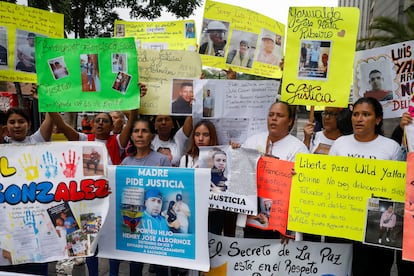The tortuous search for Ricardo Prada, the disappeared Venezuelan deported to El Salvador’s mega-prison
According to organizations and activists, the 32-year-old is not the only detainee whose whereabouts remain unknown. Human Rights Watch says the situation amounts to ‘forced disappearances’

Ricardo Prada Vásquez has been found, but he is in a place no one wants to end up. The 32-year-old Venezuelan, whom family and friends had been searching for days, is now at the Center for the Confinement of Terrorism (CECOT), El Salvador’s mega-prison to which the Donald Trump administration sent about 252 Venezuelan migrants accused of being criminals.
“They tell me he also ended up in El Salvador and is linked to the Tren de Aragua,” confirms Prada’s friend in the United States, who prefers to remain anonymous for fear of facing the same fate.
Prada’s name does not appear in the records of U.S. detention centers or the ICE detainee tracking system, nor does it appear on any of the lists published by the media days after three planes departed from Texas and landed in Central America with hundreds of inmates on board. With no trace of Prada and no information until now about whether he was alive or dead, there are now questions about whether more people have actually been deported than the U.S. government has been willing to admit.
Gris Vogt, a Mexican-American woman in contact with Prada’s relatives, and who uses her TikTok account to give a voice to people sent to CECOT, confirmed that Prada has been found. “Since March 14, the family hadn’t heard from Ricardo, and they were very afraid to speak out. But this isn’t the only case; many people are still searching for their relatives,” she tells EL PAÍS.

On Tuesday, when the case of a missing ICE detainee made headlines, the Department of Homeland Security (DHS) publicly acknowledged on social media that the young man “was expelled” to El Salvador on March 15, the same day the first 238 detainees were sent. In response to an article published by The New York Times, the Department called the report “false” and claimed that, after Prada’s arrest and a subsequent investigation, they concluded he was “a public safety threat as a confirmed member of TdA [Tren de Aragua] and in violation of his conditions admission.”
On January 15, five days before Donald Trump took office, Prada — a food delivery driver in Detroit, Michigan, who had entered the United States legally in November 2024 through the CBP One app — was detained while delivering a McDonald’s order. He mistakenly crossed the Ambassador Suspension Bridge, which rises about 118 meters above the Detroit River and connects the U.S. city with Windsor, Ontario, Canada.
When he attempted to re-enter the United States, Prada — the father of a four-year-old boy — was detained by authorities. Initially, it was reported that the Venezuelan national was being held at the Calhoun County Correctional Facility in western Michigan. Later, it was revealed that he had been transferred to an ICE detention center in Ohio, and eventually to the El Valle detention center in Texas, the same location from which the deportation flights organized by Trump’s administration began departing.
Since February 27, the day he was issued a deportation order, Prada knew he would likely be expelled from the country, but he always believed he would end up in Caracas — just as dozens of other detainees had thought. Instead, without prior notice, they were sent to El Salvador. Family members have condemned the lack of transparency and communication with the detainees. Some only learned their loved ones had been sent to CECOT after identifying them from tattoos or physical features in the images released from the prison. Days later, media outlets published the lists of those deported to El Salvador. The people searching for Prada never saw him in the videos, nor in any records that provided information about his whereabouts.

But he’s not the only inmate whose whereabouts are unknown. Gris Vogt says she has helped other Venezuelan and Salvadoran mothers locate their children in prisons in New York or Baltimore, after weeks without any news.
Neiyerver Adrian Leon Rengel, a 27-year-old Venezuelan barber who was arrested on March 13 in Dallas, is another name that never appeared on the notorious deportee list. His relatives first learned of his detention through an Instagram post by ICE. When they called the Hidalgo center where he was held on March 16, authorities informed them that he had been transferred. It wasn’t until March 24 that the federal agency confirmed he had been deported to El Salvador.
Juan Pappier, deputy director of the Americas Division at Human Rights Watch (HRW), an organization investigating these deportations and recording other cases of deportees whose names do not appear on any list, tells EL PAÍS that these deportations not only violate due process, but also amount to “forced disappearances.” “From the perspective of international law, this is a crime — a serious human rights violation,” he says.
According to Pappier, it is inconceivable that the government has not yet issued an official list of deportees, beyond the one leaked to the press. He also highlights that it was only when Bukele proposed an exchange of detainees for political prisoners with Nicolás Maduro that it was revealed that 252 Venezuelans had actually been deported to El Salvador.
The first flight of deportees departed on March 15, carrying 238 inmates. On March 31, the State Department announced that 17 more suspected gang members had been deported to the Central American country. On April 13, El Salvador’s Minister of Security announced the arrival of 10 more individuals from Guantánamo. Some of their families have still not heard from them.
“Families should not have to rely on the work of journalists to discover the whereabouts of their loved ones,” says Pappier. “The state has an obligation to disclose the whereabouts of these people. This is extremely cruel and causes immense suffering for the families.”
Sign up for our weekly newsletter to get more English-language news coverage from EL PAÍS USA Edition
Tu suscripción se está usando en otro dispositivo
¿Quieres añadir otro usuario a tu suscripción?
Si continúas leyendo en este dispositivo, no se podrá leer en el otro.
FlechaTu suscripción se está usando en otro dispositivo y solo puedes acceder a EL PAÍS desde un dispositivo a la vez.
Si quieres compartir tu cuenta, cambia tu suscripción a la modalidad Premium, así podrás añadir otro usuario. Cada uno accederá con su propia cuenta de email, lo que os permitirá personalizar vuestra experiencia en EL PAÍS.
¿Tienes una suscripción de empresa? Accede aquí para contratar más cuentas.
En el caso de no saber quién está usando tu cuenta, te recomendamos cambiar tu contraseña aquí.
Si decides continuar compartiendo tu cuenta, este mensaje se mostrará en tu dispositivo y en el de la otra persona que está usando tu cuenta de forma indefinida, afectando a tu experiencia de lectura. Puedes consultar aquí los términos y condiciones de la suscripción digital.
More information
Archived In
Últimas noticias
‘How does it feel to be a failure?’: Elizabeth Berkley’s journey from ‘Showgirls’ ridicule to vindication
The story of the Málaga virus: The code that haunted Google’s cybersecurity center director for 30 years
The impact of Ecuador’s mega-prison: A polluted river, cleared forests and military checkpoints
Corinne Low: ‘I’m more concerned about the female happiness gap than the gender wage gap’
Most viewed
- The low-cost creative revolution: How technology is making art accessible to everyone
- Christian Louboutin: ‘Young people don’t want to be like their parents. And if their parents wear sneakers, they’re going to look for something else’
- All the effects of gentrification in one corner of Mexico’s Colonia Roma
- Liset Menéndez de la Prida, neuroscientist: ‘It’s not normal to constantly seek pleasure; it’s important to be bored, to be calm’
- Christmas loses its festive spirit: ICE fears cast shadow over religious celebrations









































